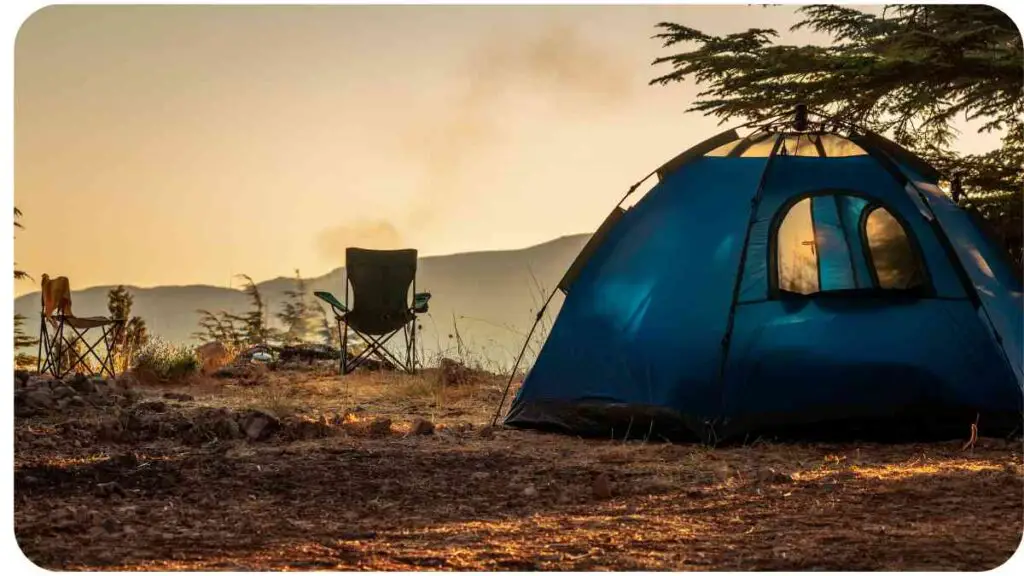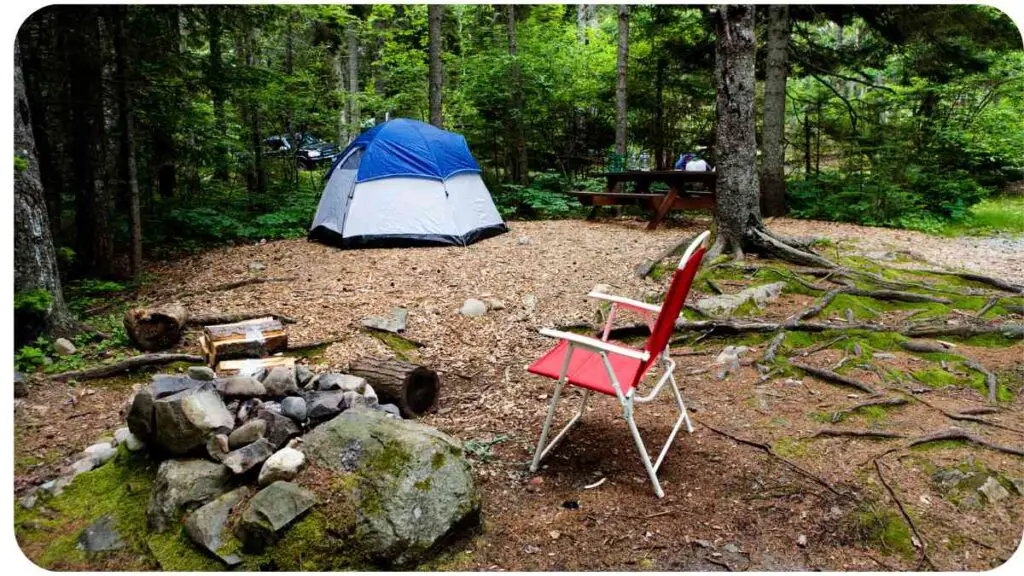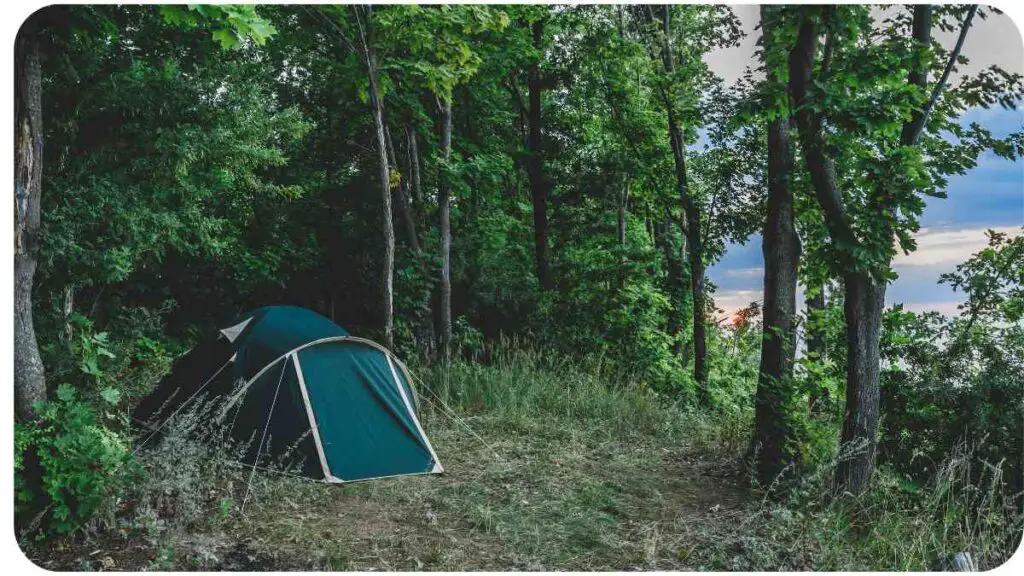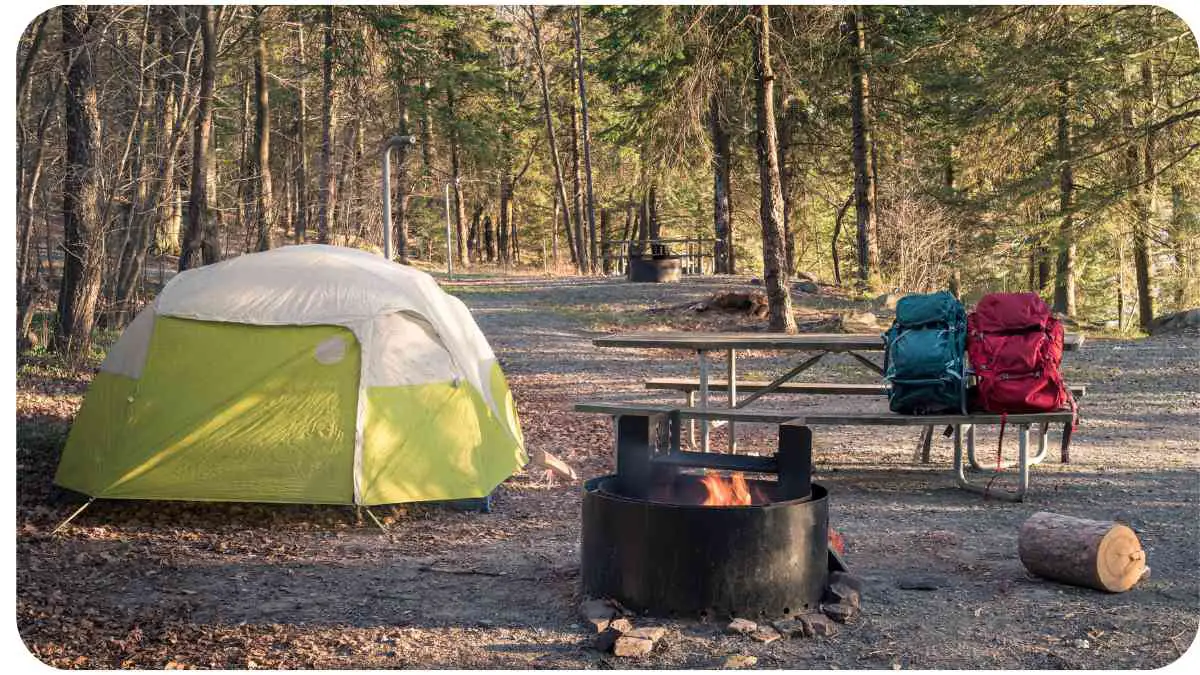Welcome to the comprehensive guide on mastering the setup of your Coleman tent! As an avid outdoor enthusiast with years of experience in camping and tenting, I’m excited to share my expertise, tips, and personal insights with you.
Setting up a tent can sometimes be daunting, especially if you’re a beginner, but fear not! By following this step-by-step guide, you’ll soon be a tent setup pro, ready to embark on countless adventures.
| Takeaways |
| Practice setting up your tent at home before camping |
| Choose a level campsite away from hazards |
| Keep tent components organized for easy setup |
| Collaborate with others for a fun setup experience |
| Proper ventilation prevents condensation |
| Stake down your tent for stability |
| Invest in quality stakes and guylines |
| Set up a vestibule for organized gear storage |
| Clean and dry your tent before storage |
| Follow storage guidelines to prevent damage |
| Learn from expert insights for efficient setup |
2. Essential Equipment for Tent Setup
Before we dive into the setup process, let’s make sure you have the right tools for the job. Here’s a quick rundown of the essential equipment you’ll need:
“When setting up your Coleman tent, it’s essential to choose from the best camping tents available. A quality tent ensures a comfortable camping experience.”
| Equipment | Purpose |
| Coleman Tent | Your temporary home in the wilderness |
| Tent Poles | Structural support for the tent |
| Rainfly | Provides protection from rain |
| Stakes and Guylines | Secures the tent to the ground |
| Ground Cloth or Tarp | Extra layer of ground protection |
| Hammer | Helps drive stakes into the ground |
| Tent Repair Kit | For quick fixes in case of emergencies |
3. Choosing the Right Campsite

Selecting the perfect campsite is crucial for a successful tent setup. Look for a level and well-drained area away from potential hazards like dead trees or steep slopes. Proximity to a water source is convenient, but avoid setting up too close to prevent flooding. Remember, your campsite’s location can make or break your outdoor experience.
4. Unpacking and Organizing Components
As you unpack your Coleman tent, take a moment to organize its components. Lay out the tent body, rainfly, poles, stakes, and guylines in an orderly manner. This not only helps you visualize the setup but also ensures you have all the necessary parts.
In the next section, we’ll delve into the step-by-step process of assembling your Coleman tent. With each step, I’ll share personal anecdotes and expert advice to make the process smoother for you. Whether you’re a novice camper or a seasoned pro, these insights will come in handy.
“Prioritize camping safety for a worry-free adventure. Learn expert tips to keep your camping trip both enjoyable and secure.”
5. Tent Assembly Steps
Setting up your Coleman tent can be an enjoyable experience when you follow these step-by-step instructions. Let’s get started:
5.1 Preparing the Ground
Just like building a house, a solid foundation is essential for your tent. Clear the area of any debris, rocks, or sharp objects that could puncture the tent floor. Lay down a ground cloth or tarp to provide an extra layer of protection against moisture and abrasions.
5.2 Lay Out the Tent Body
Unfold the tent body and position it over the prepared ground. Make sure the entrance is facing the direction you want and that there’s enough space around for staking and guyline placement.
5.3 Assemble the Poles
Assembling the tent poles can be a bit tricky, especially if you’re doing it for the first time. Consult the tent’s manual for specific instructions, as different Coleman tents may have slightly different pole designs. Typically, you’ll connect the pole sections and slide them through the corresponding pole sleeves on the tent body. Once the poles are in place, secure them at the corners and ridge with the provided clips or fasteners.
“Elevate your camping experience with delicious meals. Explore campfire cooking recipes that will satisfy your outdoor culinary cravings.”
5.4 Attach the Rainfly
The rainfly is your shield against the elements. Stretch it over the tent body and align the attachment points with the tent’s grommets or buckles. Secure the rainfly by attaching the provided straps or buckles to the tent’s frame. This not only offers protection from rain but also provides an extra layer of insulation.
5.5 Staking and Guying

Stabilize your tent by staking it down. Insert the stakes through the designated loops or grommets around the tent’s perimeter. For added stability, use guylines to anchor the tent at strategic points. Tension the guylines to keep the tent taut and prevent flapping in windy conditions.
| Staking and Guying Tips |
| – Angle the stakes away from the tent: This provides better holding power. |
| – Tighten guylines gradually: Avoid over-tightening, as it could damage the tent. |
| – Use bright-colored guylines: They prevent tripping and make your tent visible. |
In the following section, I’ll share some expert tips that will enhance your tent setup experience and ensure your camping trip starts off on the right foot. Whether you’re a beginner or a seasoned camper, these insights will come in handy.
“Stay informed on how to stay safe while camping in the USA. Expert advice ensures a protected and enjoyable camping journey for you and your companions.”
6. Tips for a Smooth Setup
Here are some valuable tips to streamline your Coleman tent setup process and make it even more enjoyable:
- Practice at Home: Before your camping trip, practice setting up your tent in your backyard. Familiarity with the process will save time and reduce stress at the campsite.
- Bring Extra Stakes and Guylines: Having spare stakes and guylines can be a lifesaver in case any get lost or damaged during setup.
- Arrive Early: Setting up your tent in daylight ensures better visibility and prevents rushing through the process.
- Collaborate: If you’re camping with friends or family, involve them in the setup. It can be a fun team activity.
- Keep Components Organized: Use labeled bags or containers to keep tent components organized during transport and setup.
- Level Ground is Key: Look for level ground to prevent uncomfortable sleeping angles and rainwater accumulation.
- Wind Direction Matters: Position your tent’s entrance away from the prevailing wind to minimize drafts.
- Check the Weather Forecast: Being prepared for changing weather conditions can help you make adjustments to your setup strategy.
- Use a Footprint: A footprint or ground cloth under your tent can protect the floor from abrasions and moisture.
- Utilize Natural Windbreaks: Set up your tent near natural windbreaks like trees or large rocks for added protection.
Remember, mastering tent setup takes practice, and every camping trip is a chance to refine your skills. With each setup, you’ll become more efficient and confident in your abilities.
7. Common Mistakes to Avoid
Even experienced campers can make mistakes during tent setup. Here are some common pitfalls to steer clear of:
- Skipping the Rainfly: Don’t underestimate the weather. Always install the rainfly to stay dry in unexpected rain showers.
- Uneven Staking: Ensure your tent is taut and level by staking it evenly. Uneven staking can lead to discomfort and instability.
- Over-Tightening Guylines: Over-tightening guylines can strain the tent fabric and poles. Maintain a balanced tension.
- Not Checking for Hazards: Look up and around for potential hazards like branches that could fall on your tent.
- Neglecting Ventilation: Proper ventilation prevents condensation inside the tent. Leave windows slightly open, even in cooler weather.
Next, let’s explore precautions to take when setting up your Coleman tent in unfavorable weather conditions. Being prepared for challenging weather can ensure your camping experience remains enjoyable and safe.
“Don’t forget any essentials when camping. Use the ultimate camping checklist to ensure you’re well-prepared for a hassle-free and enjoyable adventure.”
8. Bad Weather Setup Precautions

Camping in inclement weather requires special attention to ensure your tent setup remains sturdy and comfortable. Here are precautions to take when the elements aren’t on your side:
- Rainy Conditions:
- Set up your rainfly first to keep the interior dry during assembly.
- Avoid touching the inner tent walls while setting up, as this can transfer moisture.
- Create a small trench around the perimeter of your tent to divert rainwater.
- Windy Conditions:
- Stake your tent down securely and use extra guylines for additional stability.
- Angle your tent’s entrance away from the prevailing wind direction.
- Place heavy objects inside the tent corners to prevent it from lifting.
- Cold Conditions:
- Keep your tent’s vents slightly open to prevent condensation buildup.
- Place a foam or insulated sleeping pad under your sleeping bag to insulate against the cold ground.
- Dress in layers to regulate your body temperature while inside the tent.
- Hot Conditions:
- Opt for a shady campsite or set up under a tarp to reduce direct sunlight exposure.
- Leave windows and vents open for cross-ventilation to cool down the tent interior.
- Consider using a reflective rainfly to deflect sunlight and heat.
Remember, safety should always be your top priority. If conditions become too severe, it’s okay to delay setting up or seek shelter elsewhere. Your well-being is paramount.
9. Tent Care and Maintenance
Proper care and maintenance of your Coleman tent can extend its lifespan and ensure it serves you well for many camping trips to come. Here are some guidelines to follow:
9.1 Cleaning and Drying
After your camping adventure, make sure to clean and dry your tent thoroughly before storing it. Here’s how:
| Cleaning and Drying Tips |
| – Shake out debris: Remove dirt and debris from both the inside and outside of the tent. |
| – Use a mild detergent: Gently clean any stubborn stains with a mild soap and water solution. |
| – Rinse thoroughly: Ensure all soap residue is removed by thoroughly rinsing the tent. |
| – Dry completely: Hang the tent in a shaded area to air dry. Avoid direct sunlight, as it can damage the fabric. |
9.2 Storage Guidelines
Proper storage can prevent mold, mildew, and fabric damage. Follow these storage guidelines:
| Storage Guidelines |
| – Store in a cool, dry place: Avoid damp or humid storage areas to prevent mold growth. |
| – Loosely fold or roll: Folding the tent in the same way every time can weaken creases. |
| – Use a breathable storage bag: A mesh or fabric bag allows the tent to breathe and prevents moisture buildup. |
In the next section, I’ll share insights from seasoned campers and experts on how to set up your Coleman tent with maximum efficiency and minimal stress. Their perspectives and tips can help you refine your setup process even further.
10. Expert Insights on Efficient Setup
To gain further insights into mastering the Coleman tent setup, I reached out to seasoned campers and outdoor experts. Here’s what they had to say:
Sarah, Outdoor Enthusiast: “When setting up my Coleman tent, I always lay out all the components before starting. It helps me spot any missing parts and mentally prepare for the process. I also keep a small notebook with setup notes for each camping trip. This way, I can refer to my past experiences and make improvements.”
Mark, Camping Gear Specialist: “One tip I always give is to practice your tent setup at home. This not only familiarizes you with the process but also helps you identify any potential challenges. Additionally, I recommend investing in quality tent stakes and guylines. They make a significant difference, especially in windy conditions.”
Jennifer, Nature Photographer: “For photographers like me who need quick access to gear, I recommend setting up a vestibule outside the tent entrance. This space acts as a buffer between the outdoors and the tent interior, keeping the interior clean and organized. It’s perfect for storing muddy boots, camera equipment, and more.”
Tom, Camping Instructor: “When teaching newcomers, I emphasize the importance of teamwork. Setting up a tent with a partner not only speeds up the process but also fosters a sense of camaraderie. It’s a great opportunity to bond and share the excitement of the upcoming adventure.”
As you can see, there’s no shortage of tips and tricks from those who have spent countless hours under the stars. Incorporating their wisdom into your setup routine can significantly enhance your camping experience.
11. Frequently Asked Questions (FAQs)
Q1: Can I set up my Coleman tent on any type of terrain?
A: While Coleman tents are designed for versatility, it’s best to choose level ground that’s free from sharp objects. Avoid setting up on rocky, steep, or uneven terrain.
Q2: How do I prevent condensation inside my tent?
A: Proper ventilation is key. Leave windows slightly open and use the tent’s vents to allow air circulation. Additionally, avoid cooking or breathing inside the tent to reduce moisture buildup.
Q3: Is it necessary to stake down my tent in good weather?
A: Yes, staking down your tent provides stability, even in calm weather. It prevents the tent from shifting or collapsing due to sudden gusts of wind.
Q4: How can I make my tent more comfortable?
A: Use foam sleeping pads or air mattresses for cushioning, and bring cozy blankets or sleeping bags suitable for the weather. Organize your gear to create a clutter-free interior.
Now, let’s wrap up our comprehensive guide by summarizing the key takeaways and providing a final thought for readers to ponder.
12. Conclusion
Congratulations, you’ve now gained the knowledge and confidence to master the setup of your Coleman tent like a pro! By following this step-by-step guide, incorporating expert insights, and learning from common mistakes, you’re well-equipped to create a comfortable and secure home away from home during your outdoor adventures.
Remember, setting up a tent is not just a practical task—it’s an opportunity to connect with nature, bond with fellow campers, and create lasting memories. Whether you’re embarking on a solo journey of self-discovery or enjoying quality time with friends and family, your well-prepared tent setup will lay the foundation for an unforgettable camping experience.
So go ahead, embrace the thrill of exploration, the serenity of starlit nights, and the camaraderie around the campfire. With your newfound expertise, you’re ready to conquer any camping challenge and bask in the beauty of the great outdoors.
Safe travels, happy camping, and may your tent always stand strong against the elements!
Thank you for reading this comprehensive guide on mastering the Coleman tent setup. I hope you found the information valuable and inspiring for your future camping endeavors.
Further Reading
For more in-depth information and resources on mastering tent setups and enhancing your camping experience, consider exploring the following links:
- Coleman Montana 6 Tent Manual: Access the official manual for the Coleman Montana 6 tent model, complete with detailed setup instructions and maintenance tips.
- Coleman Weathermaster 6 Screened Tent Manual: This manual provides insights into setting up the Coleman Weathermaster 6 Screened Tent, offering valuable insights for a successful setup.
- How to Set Up Any Tent Fast: Pitching Different Types of Tents: This blog post from KOA provides a comprehensive guide to setting up various types of tents quickly and efficiently, helping you become a tent setup expert.
FAQs
What are some essential tips for a smooth tent setup?
A: Practice at home before your trip, arrive early at the campsite, and involve others in the setup process for a fun and efficient experience.
How do I choose the right campsite for my tent?
A: Look for level ground away from hazards, consider proximity to water sources, and assess wind direction for better ventilation.
Can I set up my tent on any type of terrain?
A: While Coleman tents are versatile, it’s best to avoid rocky, steep, or uneven terrain for a more comfortable setup.
How do I prevent condensation inside my tent?
A: Ensure proper ventilation by leaving windows slightly open and using the tent’s vents. Avoid cooking or breathing heavily inside.
Is staking down my tent necessary in good weather?
A: Yes, staking down provides stability even in calm conditions, preventing unexpected shifting or collapsing due to wind.
How can I make my tent more comfortable?
A: Use foam sleeping pads or air mattresses for cushioning, organize your gear, and bring cozy blankets or sleeping bags suited for the weather.
Feel free to explore these questions further, and remember that practice and preparation will make your tent setup experience more enjoyable and stress-free.

I’m Hellen James, and I am a camping enthusiast. I’ve been camping since I was a kid and have always loved it the fresh air, the beautiful scenery, and the great outdoors. In fact, it’s one of my favorite things to do in the summer!


